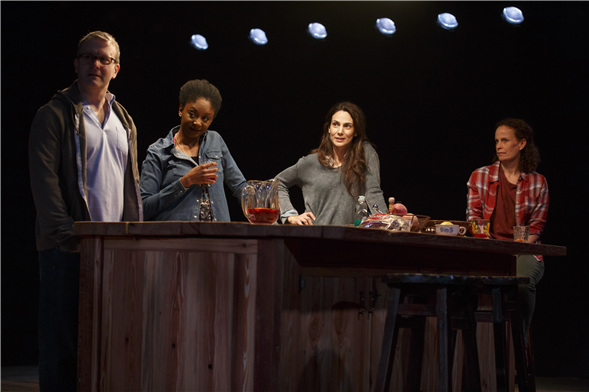Translate Page

The subtle design of Anne Washburn's new play at Playwrights Horizons
---
A wooden kitchen island – anchored to wide, rough-hewn planks – floats amid a sea of black. Above it, skeletal rafters are entangled with verdant branches. Two niche-like entrances stare out from the upstage wall, and a handful of tall grass lurks at the foot of a masked downstage entrance. Tom Petty's "Free Fallin'" spills out from the overhead speakers to greet the audience. These visual and auditory details – recognizable yet somehow distant, unreachable -- pervade Antlia Pneumatica, Anne Washburn's newest play (currently in previews at Playwrights Horizons).
Apart from the six estranged adult characters, all gathered at a Texas country home to mourn the loss of a childhood friend, the lonely kitchen island stars as the seventh player in director Ken Rus Schmoll's minimal production. On several occasions, there's nothing on stage except the set itself, silently waiting to be peopled as long sections of offstage sounds and conversations play overhead.
Scenic designer Rachel Hauck explains that part of the production's sensual aura emanates from her set's materials. "The beautiful wood that's on set is 200-year-old lumber," she says. "The reason that the world feels like it has that kind of history is because of that lumber. The island, the beams, and the floor are all made out of the same kind of wood. And it's all 200 years old. The shop did an extraordinary job milling it and manufacturing it for this show."
In her script, Washburn calls for a kitchen island with a granite countertop, a concrete floor, pecan trees, and a void around these set pieces. However, during the production process, she, Hauck, and Schmoll discovered that executing this original impulse left them feeling cold. That's when Hauck stepped in with the lumber solution. "The quality of the wood and the sound that shoes make on it, all of that stuff becomes very important," she says. "The aural world of the play is major."
Recorded sound constantly fills the air: crickets announce the stillness of the night; ice cubes echo in an empty glass; and children philosophize about ants and God. According to Hauck, sound designer Leah Gelpe set up microphones on kitchen cabinets, coffee makers, and screen doors to recreate household ambient sounds, like a Foley artist does when amplifying quotidian noises for a movie’s audio track. Simultaneously realistic and uncanny, Gelpe’s design exploits the tension between actual sounds and their artificially magnified reproductions. Like Hauck, she taps into the play’s fascination with negative space, creating suspense and manifesting the uncertainty the characters feel toward one another and death.
{Image1}
Now middle-aged and married with children, the adults of Antlia haven't seen each other in many years. Awkward conversations help them pass the time as they bake a plethora of pies for an approaching wake, the ashes of their dead friend parked atop the flour-dusted counter. Characters imagine their own epitaphs, and an old romantic flame flickers back to life as an unexpected guest arrives at the ranch. Like Washburn's previous plays, the act of storytelling—that is, people recounting memories to one another—forms a critical component of her dramaturgy. At times it feels as if the audience has gathered around a radio to listen to the latest installment of a serial. Despite the live, visual component of the show, what's most salient in Antlia is what the audience must infer from the shadows.
Richly detailed at its center and sparse toward its outer edges, the set also suggests half-seen world. "The audience will never see this, but what's in that basket has been a really fun journey for us," Hauck says, referring to a wire basket full of root vegetables and various condiments that sits on the kitchen island. "There are little photographs, matches, an iPod, and stuff that gives the place a little more history and life. All the cabinets are full even though we only open one. It's a very full world, and I think you can really feel that."
This environment is intentionally subtle. Antlia avoids capital-t theatrical spectacle, marveling instead at the domestic smallness of life. The ancient wood, the offstage recordings, Tyler Micoleau's slight-of-hand lighting—these production elements correspond with the simplicity of Washburn’s campfire poetics. As Hauck says, "The whisper of the gestures feel like the world of this play."
---
Nahuel Telleria is a dramaturg and writer based in New Haven.
Photos by Joan Marcus. Top photo (L to R): Nat DeWolf, April Matthis, Annie Parisse, and Maria Striar
TDF Members: Click here to browse our current discounts for theatre, dance, and concerts